Introduction to Dust Ingress Testing and Industry Relevance
Environmental testing is a critical phase in product development, ensuring that electrical, electronic, and mechanical components withstand harsh operational conditions. Among these tests, dust ingress evaluation is essential for validating the durability and sealing integrity of enclosures, connectors, and assemblies. The LISUN SC-015 Dust Sand Test Chamber is engineered to simulate fine particulate exposure, replicating real-world conditions encountered in industrial, automotive, and aerospace applications.
Compliance with IEC 60529, ISO 20653, and GB/T 4208 standards ensures that the SC-015 meets rigorous testing requirements for ingress protection (IP5X and IP6X). Industries such as automotive electronics, telecommunications, and medical devices rely on this equipment to verify resistance against airborne particulates, preventing premature failure due to contamination.
Technical Specifications and Functional Design of the SC-015
The LISUN SC-015 is a precision-engineered chamber designed for controlled dust and sand exposure testing. Key specifications include:
| Parameter | Specification |
|---|---|
| Chamber Volume | 0.75 m³ (SC-015) |
| Dust Concentration | Adjustable (2–4 kg/m³) |
| Particle Size | ≤ 75 µm (fine dust), ≤ 150 µm (sand) |
| Airflow Velocity | ≤ 2 m/s (adjustable) |
| Test Duration | Programmable (1 min – 99 hr) |
| Temperature Range | Ambient to +60°C (optional heating) |
| Relative Humidity | ≤ 30% (non-condensing) |
| Power Supply | 220V AC, 50/60 Hz |
The chamber incorporates a closed-loop airflow system with a cyclone separator to ensure uniform dust distribution. A variable-speed blower modulates particulate suspension, while a mesh filter prevents recirculation of oversized particles.
Testing Principles and Compliance with International Standards
The SC-015 operates on the principle of controlled particulate suspension, simulating natural dust and sand exposure. The test procedure involves:
- Sample Preparation – The device under test (DUT) is placed inside the chamber, secured in its operational orientation.
- Dust Dispersion – A regulated volume of test dust (typically talcum powder or Arizona road dust) is introduced via an automated feeder.
- Exposure Cycle – The blower circulates particulates at a defined velocity, ensuring consistent coverage.
- Post-Test Evaluation – The DUT is inspected for particle ingress, mechanical obstruction, or electrical malfunction.
The test aligns with IP5X (dust-protected) and IP6X (dust-tight) classifications, verifying enclosure integrity under prolonged particulate exposure.
Industry-Specific Applications and Use Cases
1. Automotive Electronics
Automotive components, such as ECUs, sensors, and lighting systems, must endure desert and off-road conditions. The SC-015 validates sealing effectiveness in connectors and housings, preventing abrasive damage or short circuits.
2. Telecommunications Equipment
Outdoor base stations and fiber-optic enclosures require IP6X certification to resist airborne contaminants. The chamber ensures signal integrity by testing gaskets and ventilation systems.
3. Medical Devices
Portable diagnostic equipment and surgical tools must remain operational in high-particulate environments. Dust testing confirms that filters and seals prevent internal contamination.
4. Aerospace and Aviation
Avionics systems undergo rigorous dust resistance validation to meet DO-160 and MIL-STD-810 standards, ensuring reliability in desert and high-altitude operations.
Competitive Advantages of the LISUN SC-015
- Precision Airflow Control – The SC-015’s variable-speed blower ensures repeatable test conditions, unlike basic chambers with fixed airflow rates.
- Automated Dust Recycling – A built-in cyclone separator minimizes manual intervention, reducing downtime between tests.
- Expandable Environmental Controls – Optional heating modules simulate elevated temperatures, replicating desert climates.
- Regulatory Compliance – Full adherence to IEC, ISO, and GB standards ensures globally recognized test reports.
Comparative Analysis with Alternative Testing Methods
Traditional dust testing methods, such as open-air exposure or manual dust application, lack reproducibility. The SC-015 provides:
- Quantifiable Results – Precise dust concentration measurements enable failure analysis.
- Reduced Variability – Automated dispersion eliminates human error in particulate distribution.
- Faster Certification – Pre-programmed test cycles accelerate IP rating validation.
Case Study: Dust Ingress Failure in Industrial Control Systems
A manufacturer of PLC enclosures reported intermittent failures in desert installations. Using the SC-015, engineers identified inadequate gasket sealing under prolonged dust exposure. Post-remediation testing confirmed IP6X compliance, reducing field failures by 92%.
Conclusion: Enhancing Product Reliability Through Controlled Particulate Testing
The LISUN SC-015 Dust Sand Test Chamber provides a scientifically validated method for assessing dust resistance across multiple industries. Its precision airflow, compliance with international standards, and modular design make it indispensable for R&D and quality assurance teams.
FAQ Section
Q1: What particle types are compatible with the SC-015?
The chamber supports standardized test dust, including talcum powder, Arizona road dust (ISO 12103-1), and custom particulates.
Q2: How does the SC-015 ensure uniform dust distribution?
A closed-loop airflow system with a cyclone separator maintains consistent particulate suspension, verified via internal sensors.
Q3: Can the chamber simulate high-temperature dust exposure?
Yes, an optional heating module allows testing at up to +60°C, replicating arid environmental conditions.
Q4: What maintenance is required after prolonged use?
The filter mesh and dust reservoir should be cleaned periodically to prevent clogging and ensure test accuracy.
Q5: Does the SC-015 support automated test sequencing?
Yes, programmable timers and blower controls allow unattended multi-cycle testing for high-throughput labs.







